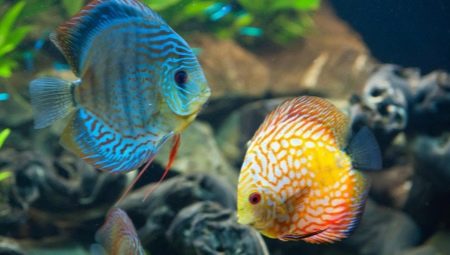Aquarium cichlids are widespread and are found on sale very often. They are characterized by truly enormous species diversity and very curious behavior. Get to know better these interesting underwater pets.
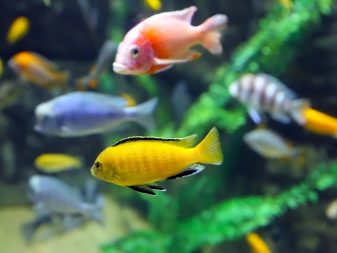

Description
Cichlids belong to the order of perciform. There are individuals with different sizes and colors. Their body shape may also vary.
In pet stores, both small and large cichlids are found. Their size can be from 2 cm to half a meter. There are also individuals whose length reaches a meter.
In the natural environment, cichlids usually live in fresh and brackish water bodies in Africa, Asia and Latin America. Unfortunately, many varieties have disappeared, and some others are on the verge of extinction.
In aquarium conditions, these fish feel very well. With proper care, such underwater pets can live from 8 to 10 years. On sale there are a great many cichlids. They may have a different appearance. There are also individuals that are distinguished by unusual, unnatural colors. Non-standard pigment is the result of artificial procedures, because of which the life span of the fish may be reduced.

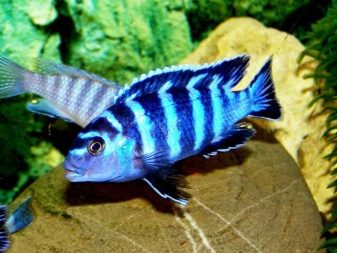
Most cichlids have a fairly large body and flattened sides. The head is large in relation to the body; the mouth is distinguished by clearly defined and outlined lips.In many species, with age, a special fatty cone forms on the forehead.
Usually, cichlids are monogamous. They choose for themselves only one partner, remain faithful to him throughout life. The fertility level in different species can vary significantly. For example, large cichlomas able to bring about 2000 eggs, and small fish that carry eggs in the mouth - no more than 100.
It is customary for cichlids to take care of their offspring. They protect both masonry and larvae. Adults can bite feed for juveniles. In most cases, both parents look after the offspring.
Although cichlids are predators, they can coexist in a common aquarium with other individuals. To avoid conflicts between underwater pets, it is necessary to correctly select neighbors for cichlids. They must be sized accordingly.

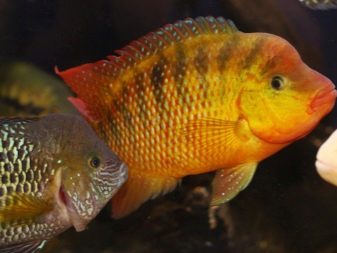
Behavior
Many aquarists are fascinated by the fact that some varieties of cichlids (mostly peaceful) can remember their master and even recognize him. In this case, the fish can take food directly from the hands of their "native" person. Such strangers may treat strangers and strangers with caution and caution.
Representatives of the described species are true family people. Even in adolescence, these fish can pair and swim, holding the fin to the fin throughout their lives.
Cichlids are great lovers of digging in the ground. Large-sized adults can uproot any aquarium vegetation, houses, caves, grottoes and other shelters without any problems. It is important to consider this feature of the behavior of cichlids, organizing comfortable conditions for them in the aquarium.
Despite the fact that cichlids are family and caring fish, they are still territorially aggressive predators. They are especially dangerous for other fish during the spawning season. Typically, these individuals clearly protect their own territory in the aquarium space. These underwater inhabitants always defend their place fiercely and fearlessly.
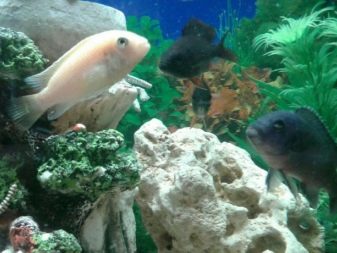
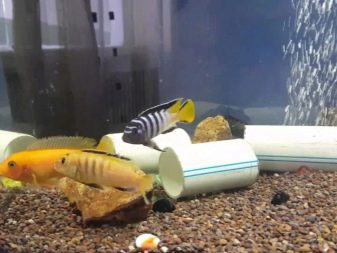
Varieties
The species of cichlids has a large number of subspecies of aquarium fish, which vary in size, color, and behavior. Let's get to know some of the most popular and widespread instances.
Astronotus
This name belongs to insanely popular and beautiful fish, which are impressive in size. In the natural habitat, these individuals grow to 35-50 cm. In the aquarium, they do not grow so much: their length reaches 15-22 cm. Astronotuses have a large head, large round eyes, and a prominent frontal part.
The color of these fish may vary. Most often, there are red decorative varieties of astronotus. The juveniles are only remotely similar to their parents and differ in coal-black color, diluted with snow-white stains and the presence of a star-like pattern throughout the body.
Many experts in the world of aquarium It is recommended that these fish be kept exclusively separately. Suitable neighbors for them will be only large southern or central American cichlids.
It is not recommended to keep excessively aggressive fish in the same aquarium with astronotuses, but too calm individuals may not be the best neighbors.
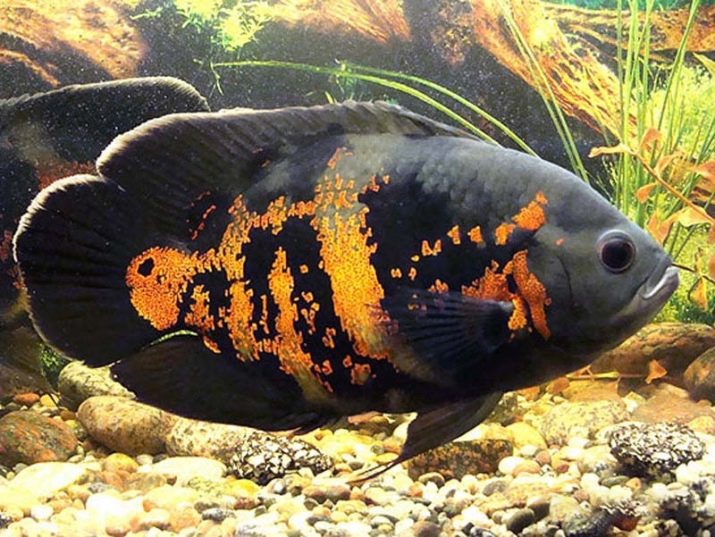
Chromis handsome
This is a very aggressive territorial fish, characterized by selfish behavior and character. The handsome Chromis boasts charisma, a beautiful appearance. This is one of the most beautiful and spectacular aquarium fish, which is hard to miss. Particular attention is drawn to the bright red color of the body of chromis, complemented by blue-green blotches that emit a beautiful light.
The length of the handsome chromis can reach 13-15 cm. These are not the highest indicators for cichlids. Their average life expectancy is only 5 years. In general, the content of this species does not cause any particular difficulties.
The main problem is that these fish, with their bright and variegated color, often conquer newcomers to the aquarium, who subsequently add chromis in one tank with small neighbors. Of course, the last cichlids will be systematically exterminated.
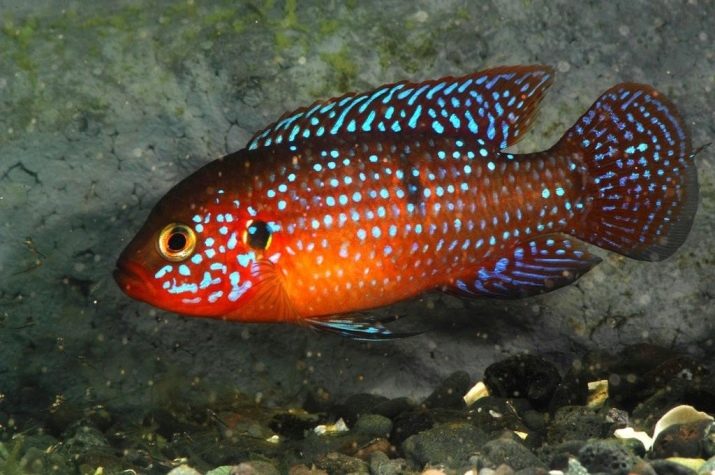
Pelmatochromis pulcher
Like the rest of the existing cichlids, these fish have a harsh disposition. In another way, representatives of this species are called krebentisami or parrots.
These are colorful cute fishes being unpretentious and undemanding in matters of care. They belong to the dwarf type of cichlids, which makes them popular among people who do not have the opportunity to have a large aquarium at home.
Mature males of this species have a length of about 10 cm, and females - 7.5 cm. The sex of these fish is easy to determine. Females have shortened fins and a wide yellow stripe in the upper part of the dorsal fin. The shape of the abdomen in females is rounded.
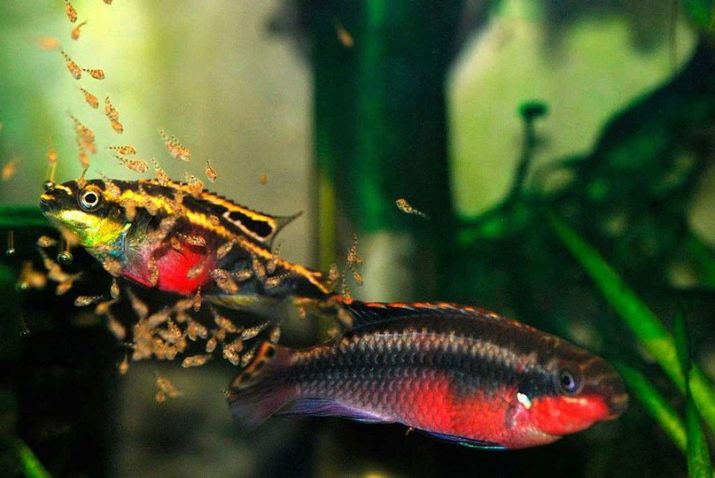
Nannakara Blue Neon
Very spectacular fish, attracting a lot of attention. They have an average size of 5-9 cm. Under good conditions, a healthy male can grow up to 12 cm.
The blue neon Nannakara is famous for its stunning colors. The body color of this fish is largely dependent on lighting. The head is distinguished by an unobtrusive grayish tint. The dorsal fin is complemented by a neat orange stripe. The eyes of these fish are usually red or orange.
These fish are very interesting. They like to watch the owners from their glass home.. From the side of Nannakara it looks like a strong, serious and powerful fish. These individuals are also predatory, therefore, they should not be kept in the vicinity of small fish. Guppies and swordsmen of Nannakara will simply eat. If these cichlids coexist with larger individuals, the latter will oppress them.
That is why it is so important to correctly select the neighbors for these underwater inhabitants.

Melanochromis auratus
The second name of this interesting fish is golden parrot. The heterogeneous cichlids of this subspecies vary in color. For males, a dark body with yellowish and blue stripes is characteristic, and for females a yellow body with dark stripes is characteristic.
This fish is recommended for experienced aquarists. Golden parrots are extremely aggressive. This is especially true for fighting males. Such a fish is hardly suitable for a general aquarium with a large number of individuals of other species.
Often these beautiful fish are bought by novice aquarists who have fallen in love with their appearance. However, over time, they notice that auratus exterminate other fish in the tank. Males of this species cannot tolerate other males and fish that are similar to them in external parameters.
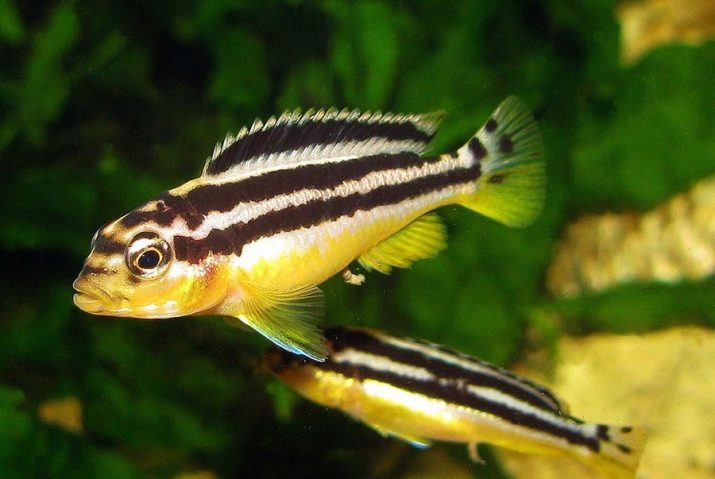
Labidochromis yellow
This is a dwarf cichlid, characterized by a bright and remarkable appearance. Individuals of different sexes have the same color. These fish are famous not only for their interesting appearance, but also for their relatively peaceful, calm disposition. Very rarely, labidochromis participate in skirmishes and fights.
The aquarium in which such a fish lives must be supplemented by a tree, on which the algae, which these pets love so much, will subsequently grow. In addition, these fish need a lot of shelters. For swimming, they need to provide enough free space. Labidochromis is an omnivorous fish. Most of all, these individuals love algae and snails.
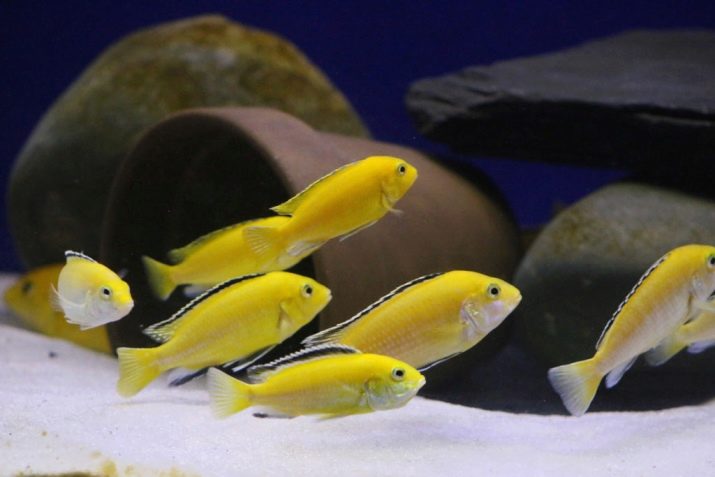
Discus
Discus fish are unusual and very beautiful fish. They are characterized by a body characterized by a disc-shaped structure, it is noticeably flattened on the sides. The head of the discus is small, the mouth is also small. The dorsal and anal fins are elongated and not very high. The tail fin is a beautiful fan.
These cichlids are peaceful and not the most mobile. Usually they stay in a small group in the middle layers of water.Discuses prefer to stay in shady places, like diffuse lighting. They can be kept in a common aquarium, but it is better to choose a view tank.
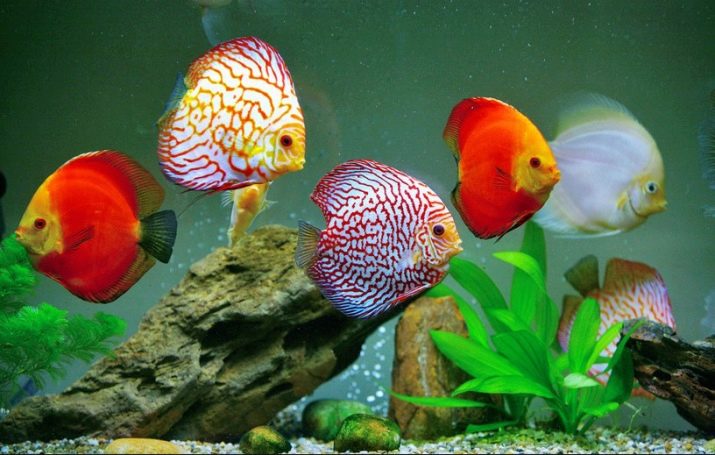
Angelfish
One of the most famous and widespread cichlids. Angelfish have a very beautiful appearance. They are started by both experienced and beginner aquarists. Today, in pet stores you can meet many different types of scalars. It can be black, marble, blue, diamond and other varieties.
Angelfish are characterized by a non-standard body shape. This fish can be tall, having an average length of 16 cm. These individuals are medium in complexity of keeping. They need a simple and spacious aquarium where they can swim unhindered.
The minimum tank volume should be 150 liters. If a glass house contains a pair of scalars or a small group, then this will not be enough. For such a number of individuals, it is recommended to prepare an aquarium with a volume of not less than 200 liters
You can keep a scalar in a common aquarium, but you must not forget that these cichlids of very small neighbors will simply be destroyed.

Growing conditions
In order to grow beautiful and healthy individuals from young cichlids at home, it is important to adhere to a number of basic rules that will achieve the desired result.
Fish must be kept in an appropriate volume in the aquarium. Newborn fry require very little free space for normal growth. It is permissible to proceed from 0.5 l of the tank volume per fish until the fry reach 2–2.5 cm. Further, the volume will need to be increased to 1 liter per 1 individual. Fish with a length of 4 cm will need an aquarium, the volume of which comes from the standard of 2 liters per individual. 6-centimeter fish will need to provide 4 liters of water each.
If the volume of the aquarium is insufficient, the cichlids will grow much more slowly. The more spacious the glass dwelling, the more happy will be the fish that live in it.
Cichlid fry grow evenly. If you feed them regularly, there will be no cases of cannibalism. The fry of the incubated subspecies after resorption of the yolk sac acquire good sizes, especially in comparison with the fry of relatives in the family grown on the substrate. This explains the differences in the size of the starting feed for fry of different subspecies of cichlids.

An ideal food for almost all varieties of cichlids is considered freshwater cyclops. This product is often used to feed fry. It is usually stored frozen. Live or frozen cyclops is a type of feed, which is the absolute guarantor of the good development of small cichlids.
Fry can acquire a beautiful color only if they are fed with crustaceans. If you feed the young solely with a tubule, growth will not slow down from this, but their color may be less saturated and bright.
For normal growth of cichlids it is necessary to take care of the normal temperature of the water in which they live. Temperature values should be stable, pH should be high (if this indicator is less than 7.5, then the consequences will be disastrous). There should be a lot of dissolved oxygen in the water.
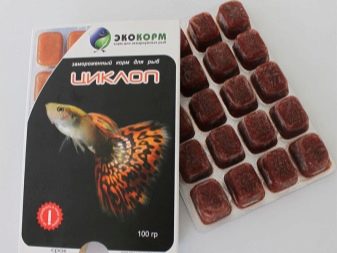

Aquarium decoration
Many varieties of cichlids are great lovers of digging soil. Because of this, many aquarists decide to completely abandon the vegetation in a glass dwelling for underwater pets. But you can find another way out - place floating plants in it that cichlids cannot harm. The normalized amount of duckweed will make it possible to decorate the tank and make it more attractive.
Experts recommend giving preference plants with hard leaves, a strong stem and a strong root system. These criteria must first meet the plants that you decide to place in the ground.
For some types of cichlids, such as discus, apistogram and microgeophagus, vegetation in the aquarium is considered a prerequisite. Greens for them serves as a good shelter, allows you to feel completely safe.
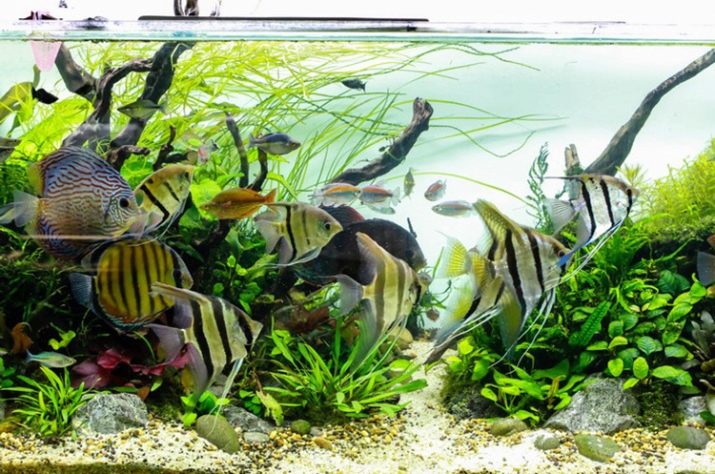
The glass tank in which cichlids live should not be overloaded with a large number of objects. Tanks should be designed deliberately, taking into account all the features of the described fish. Fishes necessarily need space, a sufficient amount of free space, where they could safely swim.
If you still decided to plant vegetation in the aquarium with cichlids, then it better placed in small groups. Plants can divide the interior of the tank. Often they are planted along the back wall.
The cichlid can be supplemented with beautiful artificial caves, grottoes, snags, pipe trunks. All of these components should not be placed above the average in a glass container. It is advisable to place them away from each other.
Caves and grottoes can be made up of flat stones or coarse pebbles. Large sinks are ideal.
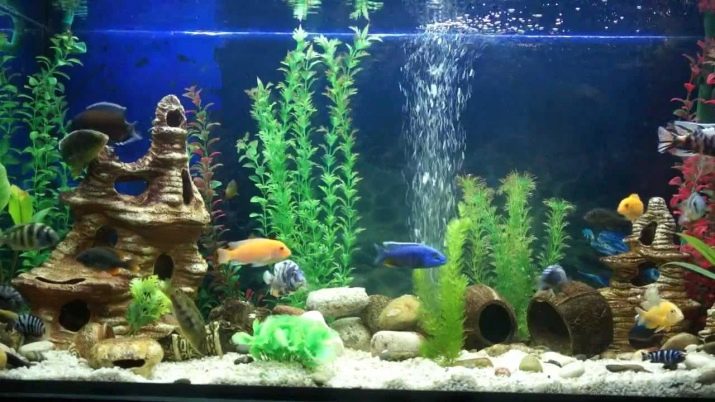
Proper care
It is important for cichlids of any subspecies to ensure proper care. The following important activities are required:
- a third of the fluid needs to be changed once a week;
- it is necessary to clean the soil from food debris and various wastes so that they do not rot and spoil the water;
- it is important to constantly monitor the state of the liquid in the tank and the fish themselves;
- feeding should be high quality and regular.
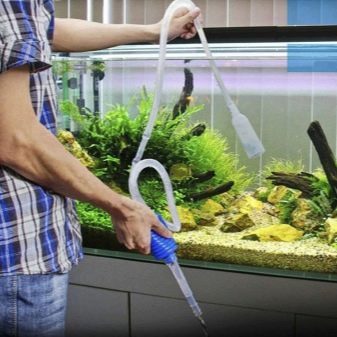
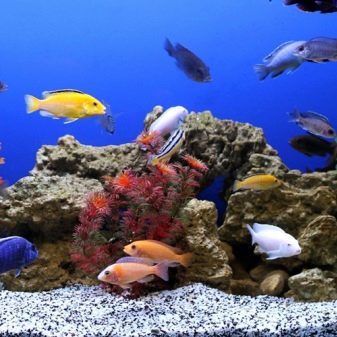
The following conditions are necessary for the content of cichlids.
- The temperature regime in the aquarium should always be stable. It is important to keep track of this. Optimum performance is 27-28 degrees. Any changes in cichlids are difficult to tolerate.
- It is important to take care of the additional enrichment of water with oxygen. Aeration and filtration are required - these are prerequisites.
- Water needs to be replaced every week.
- It should be ensured that each fish has its own nook. For this it is necessary to take care of the zoning of the internal space of the tank.
- Lighting for these predatory fish should only be moderate and scattered. Aquarium should not be placed in places where direct rays of the sun fall.
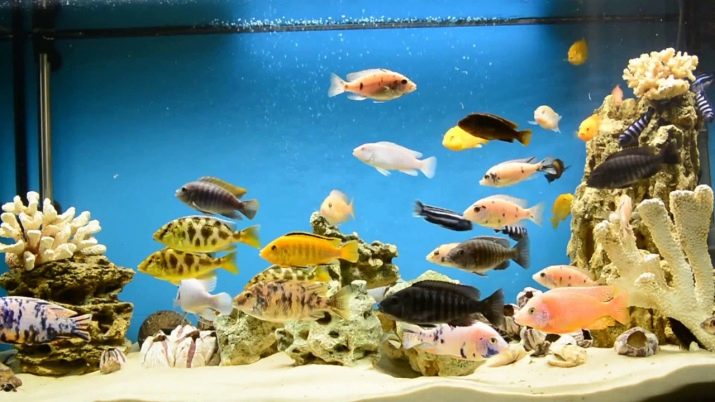
The subtleties of feeding
Feeding cichlids must be given due attention. Much depends on the specific subspecies of fish, but most representatives are not capricious and undemanding in these matters - they eat everything that they are given.
Cichlids are allowed to feed frozen or dry food. Many aquarists prefer to give their underwater pets a special nutritional mixture in the form of minced meat.
Not all cichlids are predators. Some species are herbivores - they need plant foods. It is important to take this feature into account when drawing up a balanced and maximally suitable menu for fish.
The nutrition of cichlids must be varied. Only under this condition can we talk about the good health and beauty of these underwater beauties.
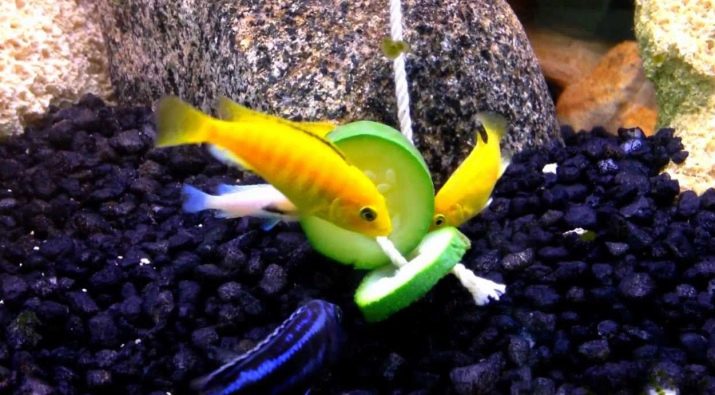
Breeding
Many aquarists are interested in home breeding of cichlids. To get offspring, it is important to deposit naturally formed pairs. If you send individuals that are not partners to spawn, they simply will not breed.
If you proceed to the jailing of fish that are not ready for reproduction or warring among themselves, then they can begin to fight. Often such events end in death. For future manufacturers it is important to prepare a separate tank of sufficient volume - spawning, in which the optimal temperature regime will be constantly maintained. It is important to correctly decorate.
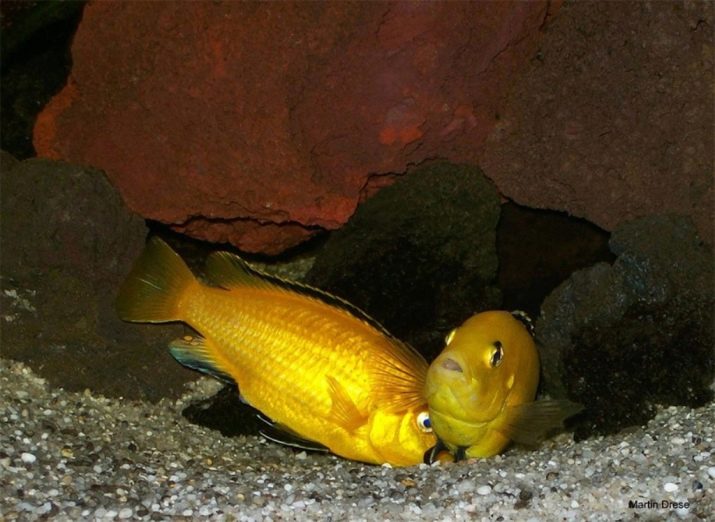
Usually cichlids lay eggs on stones and other objects in the aquarium that have a flat surface.Representatives of a number of varieties have an interesting distinguishing feature - they lay and incubate eggs in their oral cavity. Cichlids are great parents. They carefully care for caviar, and then for fry. These fish do not allow strangers to the young, protect the kids from any danger.
Owners of the aquarium need to make sure that the young consume suitable food. You can give them crustaceans, small plankton. Some aquarists prefer to feed young cichlids with special prepared foods sold in pet stores. Food should be given to fry 5-6 times a day. Servings should be small.
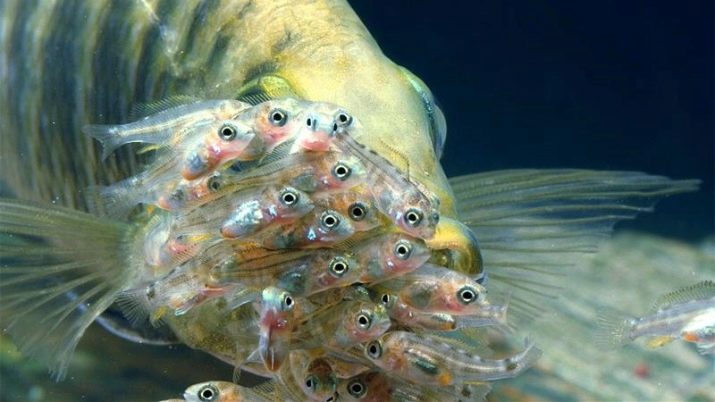
How to distinguish a female from a male?
Many people are interested in how to distinguish a female cichlid from a male. If heterosexual individuals have pronounced distinctive features regarding the structure of the body and color, then it will not be difficult to determine the female in front of you or the male. If the fish belong to monomorphic species, then to determine their gender, a thorough examination will have to be carried out.
This should only be done with wet hands. The fish will need to be carefully removed from the aquarium and turned upside down. This area of the pet's body will need to be carefully examined. Between the anal fin and the aperture there is such a part as the genital papilla. It is through this hole that caviar comes out in females during spawning, and seed in males.
In females, this hole is always large. In determining the sex of individuals in this way, certain difficulties may arise, especially when it comes to species that lay eggs in the substrate.
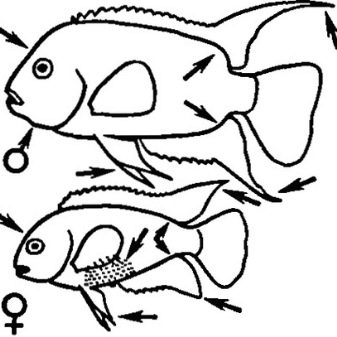
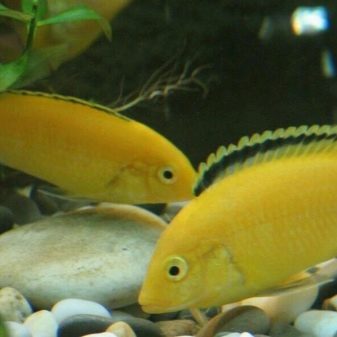
In certain situations, differences in gender can be identified, paying attention to pigmentation, which takes place in the area of the genital opening. In males, the papilla usually protrudes slightly. If you drag your finger across this zone, this feature can be noticed.
Many aquarists often rely solely on their size to determine the sex of their fish. In most cases, male cichlids are larger than females and it is not difficult to understand what their gender is.
In addition, differences in fins can be seen in most species. In males they are pointed, and in females they are rounded.
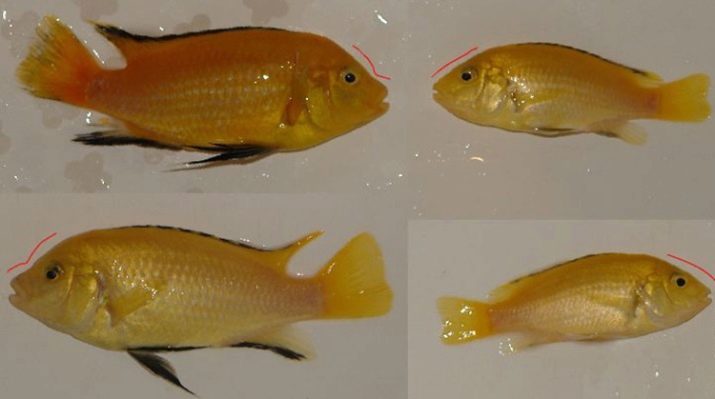
Compatible with other fish
Before you run cichlids into a common aquarium, you need to understand how they get along with other species of fish. Experts recommend keeping these little pets with relatives. Most subspecies of cichlids are predatory, therefore, they should not be kept in the same tank with small fish - for the latter, such a neighborhood will be deadly. Cichlids are straining and too slow, sedate fish.
Such fish should not be added to cichlids:
- cockerels;
- zebrafish
- goldfish;
- black telescopes;
- guppies;
- molliesia;
- swordsmen.
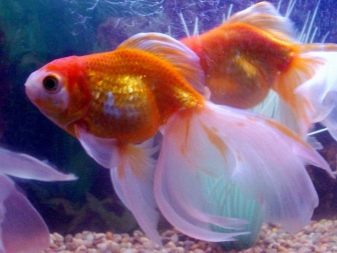
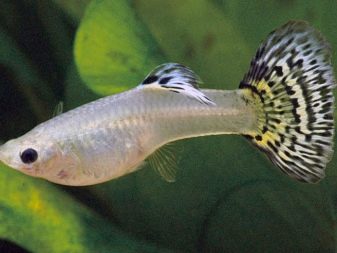
Young cichlids are often kind and can easily tolerate the neighborhood with such fish species. However, adults can hardly be called non-aggressive - they will not tolerate such neighbors.
Many of the cichlids are quite peaceful. These include Nannakaras, Pelmatochromises, and Apistograms. More aggressive and vicious are American cichlids. They constantly show a complex character, especially during the spawning season. The cichlids of the Asian group are relatively calm and accommodating.
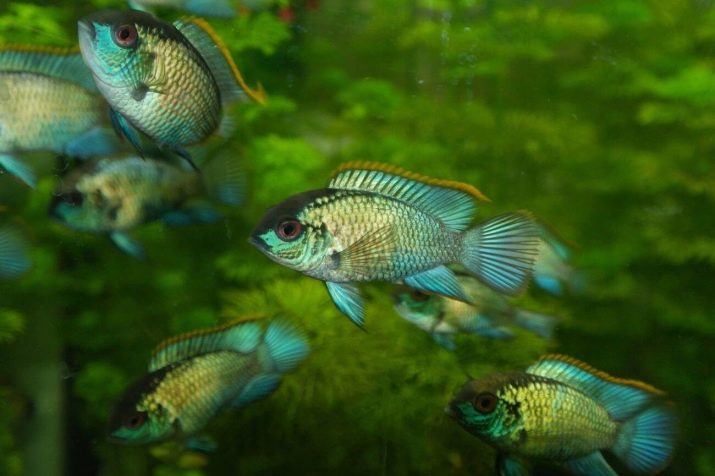
Health and Life Expectancy
Cichlids are fish that have a strong immune system. But this does not mean that they cannot get sick. If these underwater pets are not kept properly, in the end they can catch some kind of disease. The causes of infectious, bacterial or diseases of a chemical origin can be:
- poor quality nutrition;
- insufficient amount of feed consumed;
- water parameters that do not meet all the requirements;
- nitrate poisoning of fish;
- stressful conditions.
Various infections can enter the aquarium as follows:
- with new vegetation, which is bought either for design or for general arrangement of the tank;
- through soil of any type;
- with live food;
- with new fish.
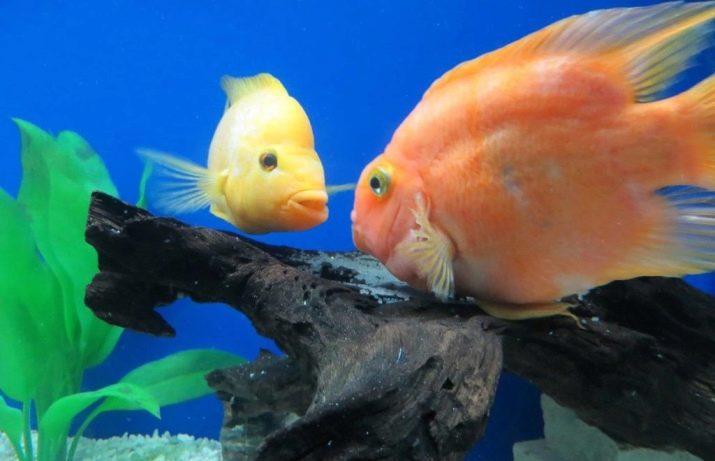
Cichlids most often suffer from such diseases.
- Hexamitosis. It is manifested by the expansion of pores in the head and sidelines. In this case, the fish do not eat, suffer from exhaustion. This disease is treated only with metronidazole. If the stage is neglected, then the pets may die.
- Ichthyophthyroidism ("semolina"). If this disease occurs, a white coating appears on the body of the fish. It can be treated only by specialized means. The use of quinine hydrochloride is allowed.
- American bloating. This disease is manifested in the inhibition of fish, as well as in their loss of appetite. The body of individuals is inflated, the eyes bulge. This disease lasts for 3 days, after which the fish die. Most often, American bloating occurs with people from Lake Malawi. You can treat the disease only with antibiotics.
- Saprolegniosis. With this disease, you can notice that on the body of the cichlids there are growths similar to cotton wool. This disease can be treated only with drugs containing phenoxyethanol.
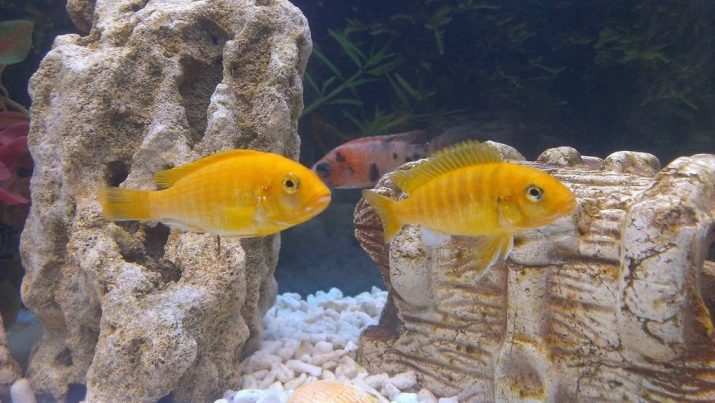
Many of the health problems of these underwater pets can be avoided by providing them with proper care. It is important to monitor the condition of the fish in the aquarium, maintain optimal water parameters and give only high-quality feed. Only under these conditions can we expect that cichlids will live long and will not hurt.
Life expectancy for different individuals is also different. In the natural habitat, cichlids can live 20-25 years, but in the aquarium, their lifespan is significantly reduced. Rare individuals can live more than a dozen years. Of course, a lot depends on the conditions in which underwater pets live.
If you contain them correctly, then they can live a very long time without suffering from diseases. If the cichlids cannot be properly maintained, they will not live a very long life.
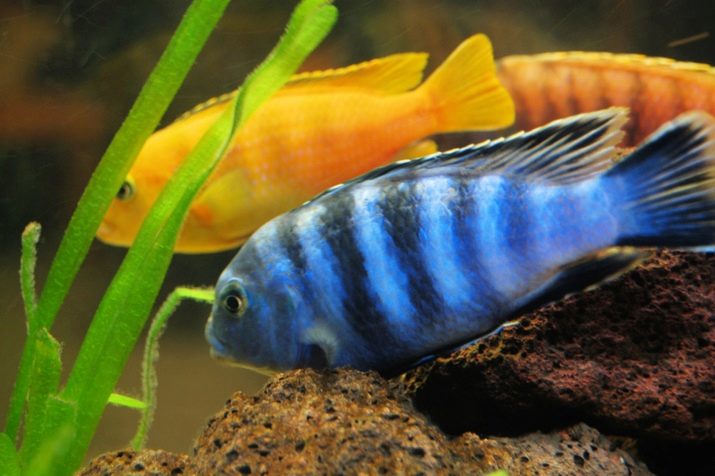
See even more about the features of cichlids in the next video.
